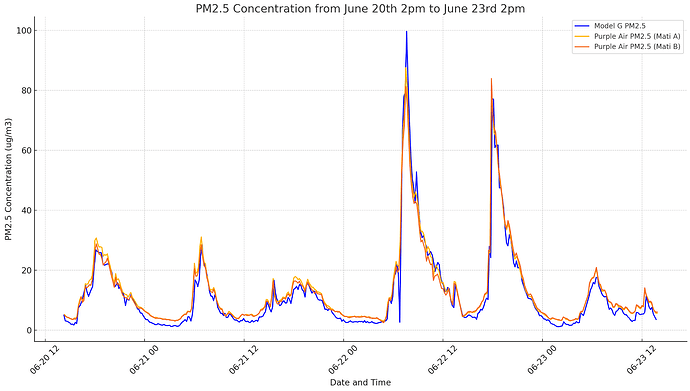Over the past few weeks, I’ve had a chance to try a few more outdoor air quality monitors, including the PurpleAir Zen, CO2 Click Model X and AirBeam 3. After using AirGradient Open Airs as outdoor monitors almost exclusively for many months, I have quite a few thoughts to share. While I have full reviews upcoming, I want to discuss the CO2 Click Model X in particular, as it’s impressed me so far.
This CAD 209 monitor comes in at roughly half the price of the PurpleAir monitors, and it’s even cheaper than the AirBeam and AirGradient monitors (unless you get the DIY kit, which is slightly cheaper). While it only has a single sensor, it is a more expensive Sensirion SPS30 (as opposed to the Plantower sensors used in all other monitors mentioned here). I’ll discuss the accuracy in more detail soon, though, as that has left me the most impressed about this device.
You are trading some other features, such as local data storage (on the PurpleAir monitors), cellular connectivity (AirBeam 3), and the ability to monitor CO2 or NOx (AirGradient Open Air), but there are also a few key benefits to the Model X - in particular, the pricing and the completely free dashboard with up to four years of data.
While each monitor certainly has advantages, and I would argue that the Model X has the least developed platform (due to it being newer and managed by a much smaller team), I have been very impressed with the device’s performance, so let’s discuss that!
All the other monitors I listed use Plantower sensors, but they use different models. AirGradient uses the PMS5003, PurpleAir the PMS6003, and AirBeam the PMS7003. However, despite the naming scheme, each of these sensors has very similar performance, with the key differences being in size and connection options. On the other hand, the Model X uses the Sensirion SPS30.
Which of these sensors is more accurate is still up in the air, as some studies point to the SPS30 performing better while others have found better performance with Plantower sensors. Either way, I tend to look at the sensors as roughly comparable - at least for PM2.5.
https://www.scirp.org/journal/paperinformation?paperid=107924
I wanted to make some comparisons, so I decided to graph the PM2.5 concentrations recorded by the Model X and a couple of PurpleAir monitors over the same period. At first, I found that the sensors recorded vastly different values, but after doing some research, I found it’s common knowledge that the PurpleAir monitors (and likely most Plantower-based devices) significantly overreport PM concentrations. For this reason, the EPA developed a correction formula to bring their readings more in line with federal reference equipment (at least for smoke and urban pollution).
Before the EPA correction. Please note that Model G is mislabeled (it should be Model X)
After EPA correction. Also, sorry for the imperfect ChatGPT graphs…
After exporting data that had been EPA-corrected, I was surprised to find that the Model X with the SPS30 and the PurpleAir devices showed very similar readings. While I’m unsure what corrections Sensirion applies, I was impressed at these results and, while I lack access to reference equipment, I would take this to mean the Model X accuracy is good.
A full review is coming up soon, but I was impressed to see the similarities in readings, and I think the Model X might be another good (lower cost) outdoor air quality monitor option!




